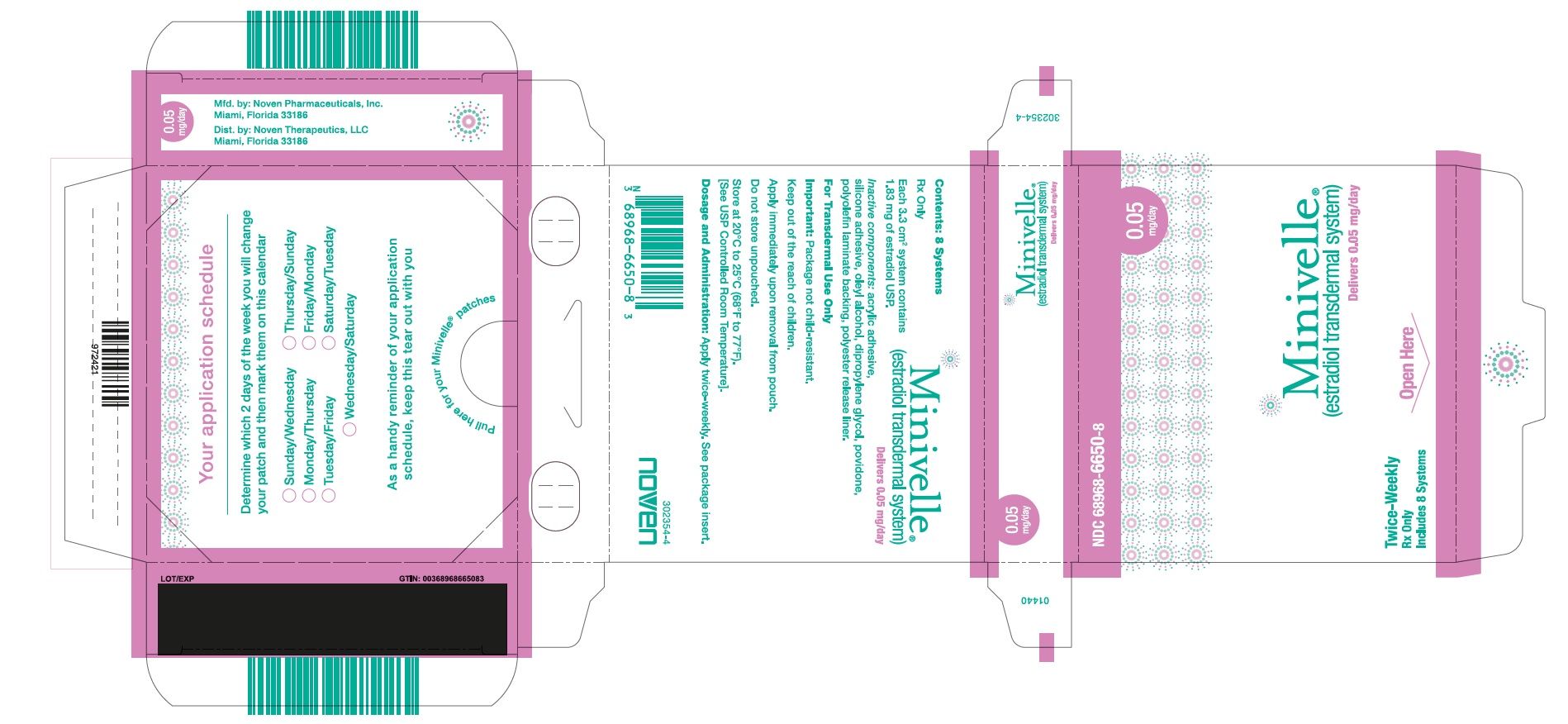Minivelle
Generic name: estradiol transdermal (skin patch)
Brand names: Alora, Climara, Estradiol Patch, Menostar, Minivelle, Vivelle-Dot
Drug class: Estrogens
Medically reviewed by A Ras MD.
What is Minivelle?
Minivelle is a prescription medicine patch (Transdermal System) that contains estradiol (an estrogen hormone). When applied to the skin as directed below, Minivelle releases estrogen through the skin into the bloodstream.
Description
MINIVELLE (estradiol transdermal system) contains estradiol in a multipolymeric adhesive. The system is designed to release estradiol continuously upon application to intact skin.
Five dosage strengths of MINIVELLE are available to provide nominal in vivo delivery rates of 0.025, 0.0375, 0.05, 0.075, or 0.1 mg of estradiol per day via the skin. Each corresponding system has an active surface area of 1.65, 2.48, 3.30, 4.95, or 6.6 cm 2 and contains 0.41, 0.62, 0.83, 1.24, or 1.65 mg of estradiol USP, respectively. The composition of the systems per unit area is identical.
Estradiol USP is a white, crystalline powder, chemically described as estra-1,3,5 (10)-triene-3,17β-diol.
The structural formula is

The molecular formula of estradiol is C 18H 240 2. The molecular weight is 272.39
MINIVELLE is comprised of three layers. Proceeding from the visible surface toward the surface attached to the skin, these layers are (1) a polyolefin laminate backing (2) an adhesive formulation containing estradiol, acrylic adhesive, silicone adhesive, oleyl alcohol, NF, povidone, USP and dipropylene glycol, and (3) a polyester release liner which is attached to the adhesive surface and must be removed before the system can be used.

The active component of the system is estradiol. The remaining components of the system are pharmacologically inactive.
Mechanism of Action
Endogenous estrogens are largely responsible for the development and maintenance of the female reproductive system and secondary sexual characteristics. Although circulating estrogens exist in a dynamic equilibrium of metabolic interconversions, estradiol is the principal intracellular human estrogen and is substantially more potent than its metabolites, estrone and estriol, at the receptor level.
The primary source of estrogen in normally cycling adult women is the ovarian follicle, which secretes 70 to 500 mcg of estradiol daily, depending on the phase of the menstrual cycle. After menopause, most endogenous estrogen is produced by conversion of androstenedione, secreted by the adrenal cortex, to estrone in the peripheral tissues. Thus, estrone and the sulfate conjugated form, estrone sulfate, are the most abundant circulating estrogens in postmenopausal women.
Estrogens act through binding to nuclear receptors in estrogen responsive tissues. To date, two estrogen receptors have been identified. These vary in proportion from tissue to tissue.
Circulating estrogens modulate the pituitary secretion of the gonadotropins, luteinizing hormone (LH) and follicle stimulating hormone (FSH) through a negative feedback mechanism. Estrogens act to reduce the elevated concentrations of these hormones seen in postmenopausal women.
What is Minivelle used for?
The Minivelle patch is used after menopause to:
- Reduce moderate to severe hot flashes
Estrogens are hormones made by a woman’s ovaries. The ovaries normally stop making estrogens when a woman is between 45 and 55 years old. This drop in body estrogen levels causes the “change of life” or menopause (the end of monthly menstrual periods). Sometimes, both ovaries are removed during an operation before natural menopause takes place. The sudden drop in estrogen levels causes “surgical menopause.”
When the estrogen levels begin dropping, some women develop very uncomfortable symptoms, such as feelings of warmth in the face, neck, and chest or sudden strong feelings of heat and sweating (“hot flashes” or “hot flushes”). In some women, the symptoms are mild and they will not need treatment with estrogen therapy. In other women, symptoms can be more severe. You and your healthcare provider should talk regularly about whether or not you still need treatment with Minivelle. - Help reduce your chances of getting osteoporosis (thin weak bones)
Osteoporosis from menopause is a thinning of the bones that makes them weaker and easier to break. If you use Minivelle only to prevent osteoporosis from menopause, talk with your healthcare provider about whether a different treatment or medicine without estrogens might be better for you.
You and your healthcare provider should talk regularly about whether you should continue treatment with Minivelle.
What is the most important information I should know about Minivelle?
- Using estrogen-alone may increase your chance of getting cancer of the uterus (womb). Report any unusual vaginal bleeding right away while you are using Minivelle. Vaginal bleeding after menopause may be a warning sign of cancer of the uterus (womb). Your healthcare provider should check any unusual vaginal bleeding to find out the cause
- Do not use estrogen-alone to prevent heart disease, heart attacks, strokes, or dementia (decline in brain function)
- Using estrogen-alone may increase your chances of getting strokes or blood clots
- Using estrogen-alone may increase your chance of getting dementia, based on a study of women 65 years of age or older
- Do not use estrogens with progestins to prevent heart disease, heart attacks, strokes, or dementia
- Using estrogens with progestins may increase your chances of getting heart attacks, strokes, breast cancer, or blood clots
- Using estrogens with progestins may increase your chance of getting dementia, based on a study of women 65 years of age or older
- You and your healthcare provider should talk regularly about whether you still need treatment with Minivelle
Who should not take Minivelle?
Do not start using Minivelle if you:
- have unusual vaginal bleeding
Vaginal bleeding after menopause may be a warning sign of cancer of the uterus (womb). Your healthcare provider should check any unusual vaginal bleeding to find out the cause. - currently have or have had certain cancers
Estrogens may increase the chances of getting certain types of cancers, including cancer of the breast or uterus. If you have or have had cancer, talk with your healthcare provider about whether you should use Minivelle. - had a stroke or heart attack
- currently have or have had blood clots
- currently have or have had liver problems
- have been diagnosed with a bleeding disorder
- are allergic to Minivelle or any of its ingredients
See the list of ingredients in Minivelle at the end of this leaflet. - think you may be pregnant
Minivelle is not for pregnant women. If you think you may be pregnant, you should have a pregnancy test and know the results. Do not take Minivelle if the test is positive and talk to your healthcare provider.
What should I tell my healthcare provider before taking Minivelle?
Before you use Minivelle, tell your healthcare provider if you:
- have any unusual vaginal bleeding
Vaginal bleeding after menopause may be a warning sign of cancer of the uterus (womb). Your healthcare provider should check any unusual vaginal bleeding to find out the cause. - have any other medical conditions
Your healthcare provider may need to check you more carefully if you have certain conditions such as asthma (wheezing), epilepsy (seizures), diabetes, migraine, endometriosis, lupus, angioedema (swelling of the face and tongue), or problems with your heart, liver, thyroid, kidneys, or have high calcium levels in your blood. - are going to have surgery or will be on bed rest.
Your healthcare provider will let you know if you need to stop using Minivelle. - are breast feeding
The hormone in Minivelle can pass into your breast milk.
Tell your healthcare provider about all the medicines you take including prescription and nonprescription medicines, vitamins and herbal supplements. Some medicines may affect how Minivelle works. Minivelle may also affect how other medicines work. Keep a list of your medicines and show it to your healthcare provider and pharmacist when you get a new medicine.
How should I take Minivelle?
For detailed instructions, see the step-by-step instructions for using Minivelle at the end of this Patient Information
- Use Minivelle exactly as your healthcare provider tells you to use it
- Minivelle is for skin use only
- Change your Minivelle patch 2 times a week or every 3 to 4 days
- Apply your Minivelle patch to a clean, dry area on your lower abdomen or buttocks. This area must be clean, dry, and free of powder, oil or lotion for your patch to stick to your skin
- Apply your Minivelle patch to a different area of your abdomen or your buttocks each time. Do not use the same application site 2 times in the same week.
- Do not apply Minivelle to your breasts
- If you forget to apply a new Minivelle patch, you should apply a new patch as soon as possible.
- You and your healthcare provider should talk regularly (every 3 to 5 months) about your dose and whether you still need treatment with Minivelle.
How to Change Minivelle
- When changing the patch, peel off the used patch slowly from the skin
- After removal of Minivelle, patients usually have either no adhesive residue or light adhesive residue. If any adhesive residue remains on your skin after removing the patch, allow the area to dry for 15 minutes. Then, gently rub the area with oil or lotion to remove the adhesive from your skin
- Keep in mind, the new patch must be applied to a different area of your abdomen or buttocks. This area must be clean, dry, cool and free of powder, oil or lotion.
What are the possible side effects of Minivelle?
Side effects are grouped by how serious they are and how often they happen when you are treated.
Serious, but less common side effects include:
- heart attack
- stroke
- blood clots
- dementia
- breast cancer
- cancer of the lining of the uterus (womb)
- cancer of the ovary
- high blood pressure
- high blood sugar
- gallbladder disease
- liver problems
- changes in your thyroid hormone levels
- enlargement of benign tumors (“fibroids”)
Call your healthcare provider right away if you get any of the following warning signs or any other unusual symptoms that concern you:
- new breast lumps
- unusual vaginal bleeding
- changes in vision or speech
- sudden new severe headaches
- severe pains in your chest or legs with or without shortness of breath, weakness and fatigue
- swelling
- rash
Less serious, but common side effects include:
- headache
- breast pain
- irregular vaginal bleeding or spotting
- stomach or abdominal cramps, bloating
- nausea and vomiting
- hair loss
- fluid retention
- vaginal yeast infection
- redness and/or irritation at patch placement site
These are not all the possible side effects of Minivelle. For more information, ask your healthcare provider or pharmacist for advice about side effects. Tell your healthcare provider if you have any side effects that bother you or does not go away. You may report side effects to Noven at 1-800-455-8070 or to FDA at 1-800-FDA-1088.
What can I do to lower my chances of a serious side effect with Minivelle?
- Talk with your healthcare provider regularly about whether you should continue taking Minivelle
- If you have a uterus, talk to your healthcare provider about whether the addition of a progestin is right for you
The addition of a progestin is generally recommended for a woman with a uterus to reduce the chance of getting cancer of the uterus (womb). - See your healthcare provider right away if you get vaginal bleeding while using Minivelle
- Have a pelvic exam, breast exam and mammogram (breast X-ray) every year unless your healthcare provider tells you something else
If members of your family have had breast cancer or if you have ever had breast lumps or an abnormal mammogram, you may need to have breast exams more often - If you have high blood pressure, high cholesterol (fat in the blood), diabetes, are overweight, or if you use tobacco, you may have higher chances of getting heart disease
Ask your healthcare provider for ways to lower your chances of getting heart disease.
General information about the safe and effective use of Minivelle
Medicines are sometimes prescribed for conditions that are not mentioned in patient information leaflets. Do not use Minivelle for conditions for which it was not prescribed. Do not give Minivelle to other people, even if they have the same symptoms you have. It may harm them.
This leaflet summarizes the most important information about Minivelle. If you would like more information, talk with your healthcare provider or pharmacist. You can ask your healthcare provider or pharmacist for information about Minivelle that is written for health professionals.
For more information, go to www.minivelle.com or call Noven Pharmaceuticals Inc at 1-800-455-8070.
How should I store Minivelle?
- Store at room temperature 68°F to 77°F (20°C to 25°C)
- Do not store Minivelle patches outside of their pouches. Apply immediately upon removal from the protective pouch
- Used patches still contain estrogen. To throw away the patch, fold the sticky side of the patch together, place it in a sturdy child-proof container, and place this container in the trash. Used patches should not be flushed in the toilet
KEEP Minivelle and all other medicines out of the reach of children
What are the ingredients in Minivelle?
Active ingredient: estradiol
Inactive ingredients: Polyester film laminate, acrylic and silicone adhesives, oleyl alcohol, NF, povidone, USP and dipropylene glycol and a polyester release liner
Instructions for use for Minivelle
(estradiol transdermal system)
You will need the following supplies (See Figure A).
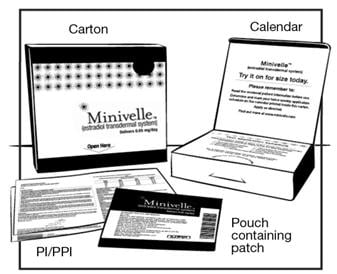
Figure A
Step 1: Pick the days you will change your patch.
- You will need to change your patch 2 times a week or every 3 to 4 days. Use the calendar printed inside your carton to choose the 2 days you will change your patch (See Figure B).
- Remember to change your patch on the same 2 days you marked on your calendar. If you forget to change your patch on the correct date, apply a new patch as soon as you remember, and continue to follow your original schedule
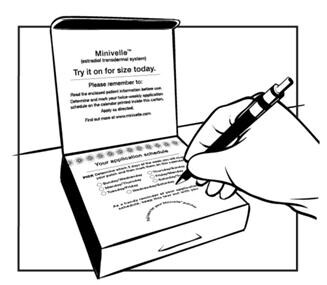
Figure B
Step 2. Remove the Minivelle patch from the pouch.
- Remove the patch from its protective pouch by tearing at the notch ( do not use scissors, See Figure C).
- Do not remove your patch from the protective pouch until you are ready to apply it
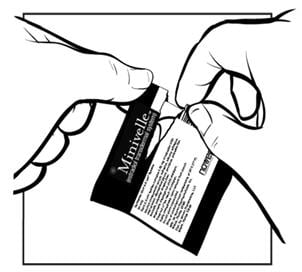
Figure C
Step 3. Remove half of the adhesive liner (See Figure D).
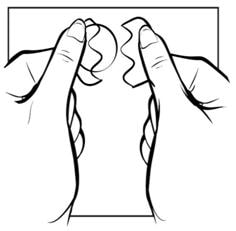
Figure D
Step 4. Placing the patch on your skin.
- Hold the part of the patch that still has the adhesive liner on it
- Avoid touching the sticky half of the patch with your fingers
- Apply the exposed sticky half of the patch to 1 of the areas of skin shown below (See Figures E and F).
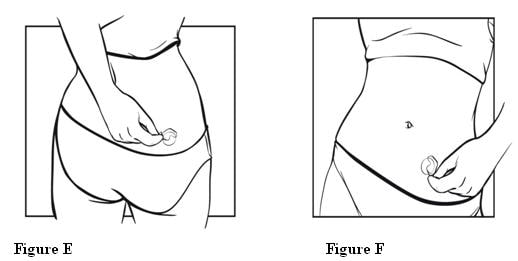
Figures E and F
Note:
- Avoid the waistline, since clothing and belts may cause the patch to be rubbed off
- Do not apply the patch to your breasts
- Only apply the patch to skin that is clean, dry, and free of any powder, oil, or lotion
- You should not apply the patch to injured, burned, or irritated skin, or areas with skin conditions (such as birth marks, tattoos, or that is very hairy)
Step 5: Press the patch firmly onto your skin.
- Remove the remaining half of the adhesive liner and press the entire patch into place with the palm of your hand for 10 seconds
- Rub the edges of the patch with your fingers to make sure that it will stick to your skin (See Figure G).

Figure G
Note:
- Showering will not cause your patch to fall off
- If your patch falls off reapply it. If you cannot reapply the patch, apply a new patch to another area (See Figures E and D) and continue to follow your original placement schedule
- If you stop using your Minivelle patch or forget to apply a new patch as scheduled, you may have spotting, or bleeding, and recurrence of symptoms
Step 6: Throwing away your used patch.
- When it is time to change your patch, remove the old patch before you apply a new patch
- To throw away the patch, fold the sticky side of the patch together, place it in a sturdy child-proof container, and place this container in the trash. Used patches should not be flushed in the toilet
Label
PRINCIPAL DISPLAY PANEL
Package Label – Principal Display Panel – 0.025mg Trade Carton
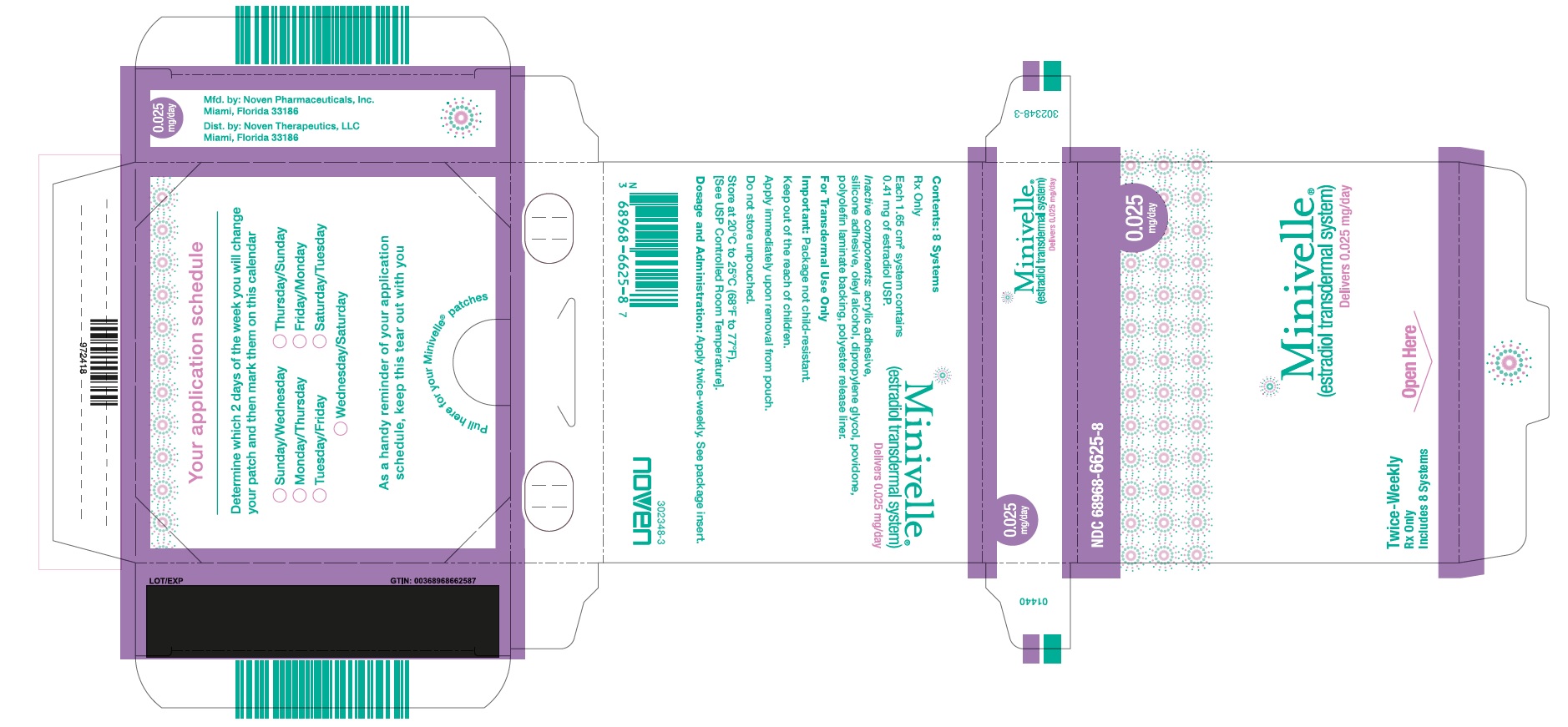
Package Label – Principal Display Panel – 0.0375mg Carton
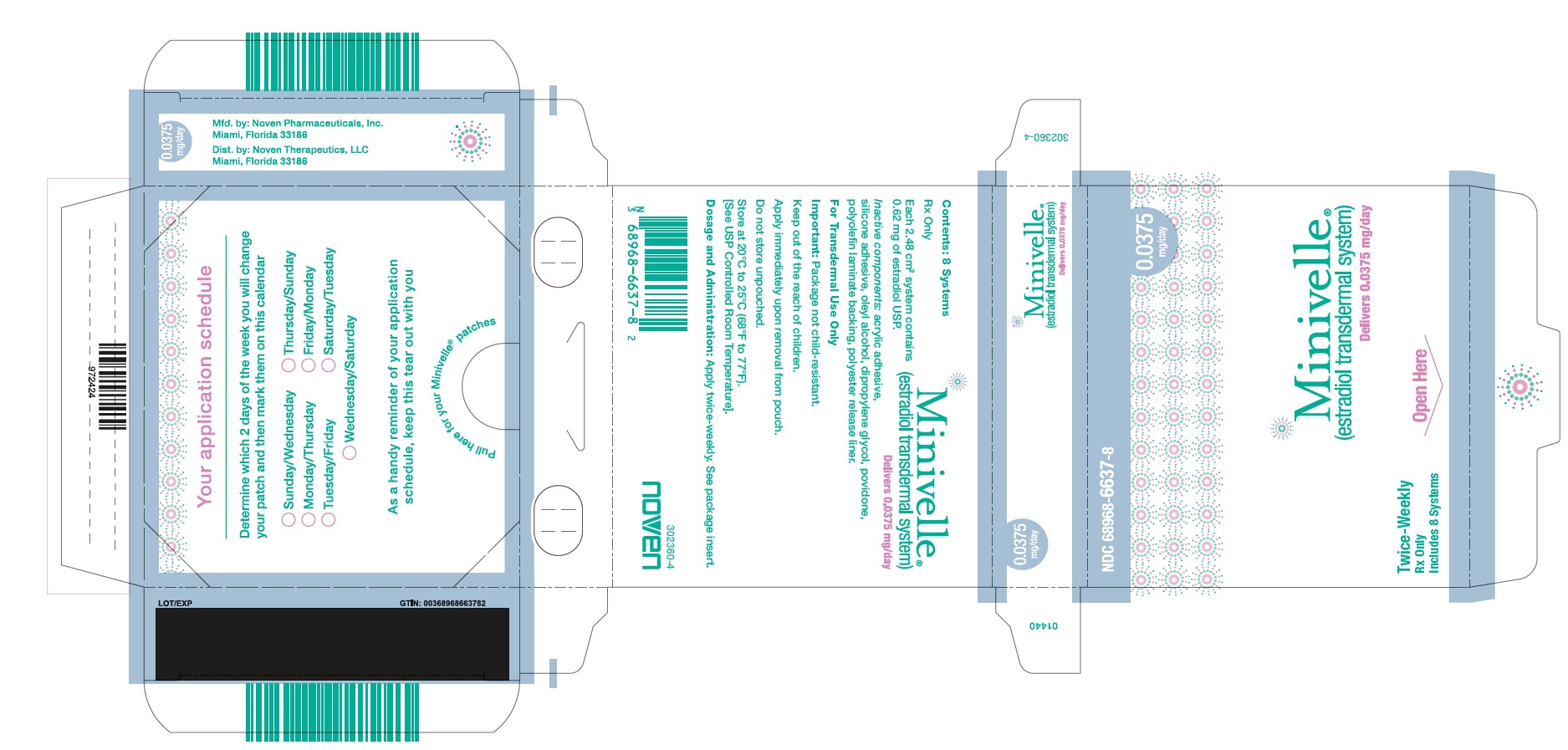
Package Label – Principal Display Panel – 0.05mg Carton
